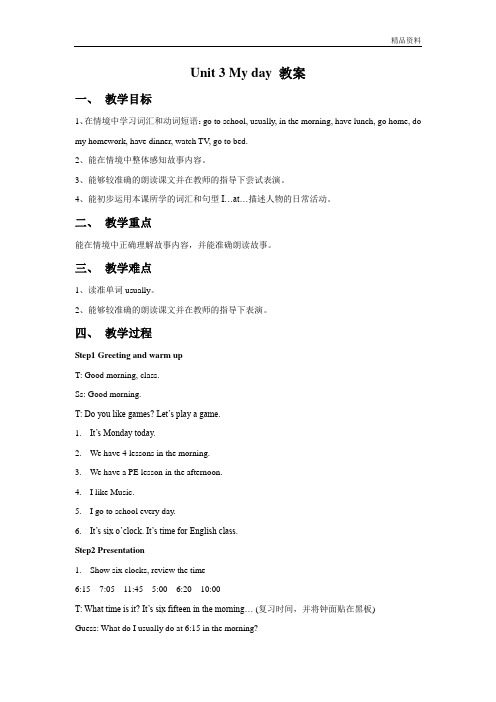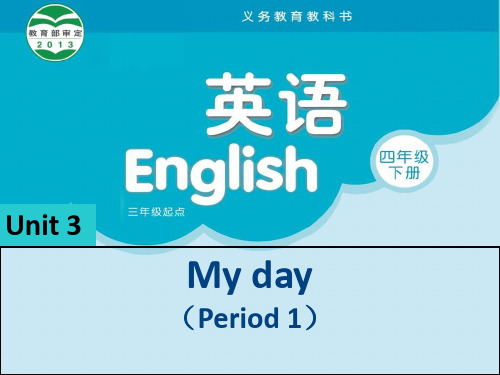2018-2019年英语译林牛津版小学四年级下册Unit 3 My day第二课时优质课教案
- 格式:doc
- 大小:34.50 KB
- 文档页数:5

四年级下册英语说课稿-Unit3 My day 译林版一、教材分析教材内容本篇教材《My day》介绍了一天中的各种活动,包括早上和晚上起床、吃早餐和晚餐、上学和放学等内容。
同时也教授了一些英语表达,如:get up, have breakfast/dinner, go to school, come back等。
教材特点本单元主要介绍一些日常生活中的活动,内容比较基础,易于学生们掌握。
同时,在学习过程中,结合许多生活场景和图片,可以更好地帮助学生们理解和记忆。
教材目标1.掌握本单元中涉及的单词和短语,如:get up, have breakfast/dinner,go to school, come back等;2.能够使用正确的语境表达一天中的各种活动;3.能够初步掌握一些英语句型和语法规则,如:一般现在时。
二、教学设计教学目标1.让学生们通过学习一天中的活动,能够在日常生活中使用英语简单对话;2.培养学生的口语表达能力;3.培养学生的学习兴趣和英语学习习惯。
教学内容1.单词和短语:get up, have breakfast/dinner, go to school, come back 等;2.一般现在时的使用;3.口语表达练习;教学步骤第一步:导入通过介绍几种日常活动场景,如:早上起床、吃早餐等,引导学生们学习本单元内容,并同时学习使用相关的英语表达。
第二步:学习单词和短语通过对单词和短语的介绍,让学生们了解相关词汇的含义,并进行一些口语表达练习。
第三步:学习语法介绍一般现在时的概念和使用方法,并进行相应的例句练习。
同时,让学生们了解和掌握一些常用谓语动词的用法。
第四步:学习用法在学习语法的基础上,引导学生们学习句型的使用方法,并进行相应的口语表达练习。
第五步:巩固与拓展让学生们运用所学的知识,进行日常生活中相关的英语口语表达练习。
同时,为了更好地拓展知识面,也可以介绍一些相关文化和背景知识。

译林版四年级英语下册课件Unit3Myday教学内容:本节课的教学内容选自译林版四年级英语下册教材,第三章"My Day"。
本节课主要围绕学生的一天生活展开,通过学习本节课,学生能够掌握日常活动的表达方式,如"go to school"、"have lunch"、"do homework"等,并能够运用一般现在时描述自己的日常活动。
教学目标:1. 学生能够听懂、会说、会读本节课的主要词汇和句型,如"go to school"、"have lunch"、"do homework"等。
2. 学生能够运用一般现在时描述自己的日常活动。
3. 学生能够通过合作交流,提高自己的口语表达能力。
教学难点与重点:重点:本节课的重点是让学生掌握日常活动的表达方式,如"go to school"、"have lunch"、"do homework"等,并能够运用一般现在时描述自己的日常活动。
难点:本节课的难点是一般现在时的运用,学生需要掌握一般现在时的构成和用法。
教具与学具准备:教具:PPT、黑板、粉笔学具:课本、练习本、文具教学过程:Step 1:热身(5分钟)教师与学生进行简单的英语对话,如"How are you?"、"What's your name?"等,引导学生进入英语学习的状态。
Step 2:引入(10分钟)教师通过提问的方式引导学生思考一天的活动,如"What do youdo in a day?",然后展示本节课的主题"My Day"。
Step 3:新课呈现(15分钟)教师通过PPT展示本节课的主要词汇和句型,如"go to school"、"have lunch"、"do homework"等,并进行讲解和示范。


Unit 3 My day 教案一、教学目标1、在情境中学习词汇和动词短语:go to school, usually, in the morning, have lunch, go home, do my homework, have dinner, watch TV, go to bed.2、能在情境中整体感知故事内容。
3、能够较准确的朗读课文并在教师的指导下尝试表演。
4、能初步运用本课所学的词汇和句型I…at…描述人物的日常活动。
二、教学重点能在情境中正确理解故事内容,并能准确朗读故事。
三、教学难点1、读准单词usually。
2、能够较准确的朗读课文并在教师的指导下表演。
四、教学过程Step1 Greeting and warm upT: Good morning, class.Ss: Good morning.T: Do you like games? Let’s play a game.1.It’s Monday today.2.We have 4 lessons in the morning.3.We have a PE lesson in the afternoon.4.I like Music.5.I go to school every day.6.It’s six o’clock. It’s time for English class.Step2 Presentation1.Show six clocks, review the time6:15 7:05 11:45 5:00 6:20 10:00T: What time is it? It’s six fifteen in the morning… (复习时间,并将钟面贴在黑板)Guess: What do I usually do at 6:15 in the morning?Ss: get up/have breakfast…T: I usually get up at 6:15.板书:I(usually)…at…Teach: usuallyT: When do you get up?Ss: I get up at…2.In the same way to teach:go to school at 7:05 have lunch at 11:45go home at 5:00 have dinner at 6:20go to bed at 10:003. T: I do different things at different time.(Chant)I get up at six fifteen. I go to school at seven o five.I have lunch at eleven fifteen. I go home at five.I have dinner at six twenty. I go to bed at ten.So this is my day.4. Talk in groups. Make a new chant, say something about your day.Step3 Story timeT: We’re having an English lesson and we’re talking about our days. Mike is talking about his day too. Let’s listen to Mike, try to find out Mike’s activities in the morning.(Part1)Ss listen and then choose the pictures.(出示五幅图:起床、看电视、上学、睡觉、吃午饭,学生听第一段,根据Mike的介绍选出早上的活动)1.Listen again and match(再听一遍介绍,出现三个钟面,将Mike的活动与时间配对)2.T: What else does Mike do in the morning?Ss: Have lessonsT: Yes. And how many lessons does he have in the morning.Ss: Four.T: So Mike has four lessons in the morning.3.Listen and read Part 1.(Part2)1. T: How many lessons does Mike have in the afternoon? And what else does Mike do in the afternoon? L et’s listen again, and try to answer.Q1. How many lessons does Mike have in the afternoon?Q2. What else does Mike do in the afternoon?Teach: go homedo my homeworkIn the afternoon: have lessons/play football/go home2.Listen and read Part 2(Part3)1. Read Part3 by selves, try to fill in the blanks.2. Talk in groups: When does Mike do these things? Say like this: …at…3. Listen and read Part3Step 4 Consolidation1. Read in three.2. Act as Mike, choose one part and talk about your activity.(三人一小组,扮演Mike,选择早、中、晚其中一个时间说说自己的活动)。


译林版四年级英语下册课件Unit3Myday一、教学内容本节课我们将学习译林版四年级英语下册的Unit 3 “My day”。
具体内容包括:1. 教材章节:Unit 3 “My day”2. 详细内容:一般现在时态的运用,描述日常活动和作息时间重点词汇:get up, go to school, have lunch, play football, do homework, go to bed等功能句型:What time do you ? I at二、教学目标1. 能够运用一般现在时态描述自己的日常活动。
2. 能够熟练掌握本课的重点词汇,并运用到实际场景中。
3. 能够运用功能句型进行问答,了解并描述他人的日常活动。
三、教学难点与重点1. 教学难点:一般现在时态的运用,特别是主语为第三人称单数时动词的变化。
2. 教学重点:熟练掌握本课的重点词汇和功能句型,并能灵活运用。
四、教具与学具准备1. 教具:PPT课件、单词卡片、钟表模型。
2. 学具:练习本、彩色笔。
五、教学过程1. 导入:通过展示一个实践情景,让学生观察并回答问题,引出本课的主题。
展示一个孩子一天的活动,引导学生用中文描述他的作息时间。
过渡到英文,让学生尝试用英文描述这个孩子的日常活动。
2. 呈现:通过PPT展示本课的重点词汇和句型,让学生跟随朗读,并模仿例句进行练习。
展示重点词汇,让学生朗读并模仿例句。
引导学生用一般现在时态描述自己的日常活动。
3. 实践:进行随堂练习,让学生分组练习用英文描述自己的日常活动。
学生分组,每人描述自己的日常活动,其他组员倾听并记录。
每组选一名代表进行汇报,其他同学进行评价。
4. 巩固:通过游戏和竞赛,巩固本节课所学内容。
设计一个“快速问答”游戏,让学生用句型进行问答。
举行一个“我的日常”演讲比赛,鼓励学生大胆开口说英语。
六、板书设计1. Unit 3 My day2. 内容:重点词汇:get up, go to school, have lunch, play football, do homework, go to bed功能句型:What time do you ? I at七、作业设计1. 作业题目:描述你的日常活动,至少使用5个本课所学的重点词汇。
四年级英语下册课件Unit3Myday译林版一、教学内容本节课的教学内容选自译林版四年级英语下册教材Unit 3 "My day"。
具体内容包括:教材第二章的对话部分,重点学习描述日常活动的时间表达和一般现在时态;以及第三章的词汇和语法练习,强化对日常作息词汇的掌握及运用。
二、教学目标1. 能够听懂并准确说出自己一天中的主要活动及其时间安排。
2. 掌握一般现在时态的用法,并能运用到日常生活的描述中。
3. 提高学生的口语表达能力和团队合作能力,通过讨论和分享增进彼此了解。
三、教学难点与重点教学难点:一般现在时态的构成及其正确运用;准确表达日常活动的时间顺序。
教学重点:日常活动词汇的记忆与运用;使用一般现在时进行句子构造。
四、教具与学具准备教具:PPT课件、时间卡片、教学录音机。
学具:学生用书、活动记录表、彩色笔。
五、教学过程1. 导入(5分钟)利用PPT展示不同时间段的日常活动图片,引导学生讨论:“What do you usually do at this time?”,通过提问方式自然引入新课。
播放教材中的对话录音,让学生听后回答问题,检测预习情况。
2. 呈现与练习(15分钟)对话分析:带领学生一起分析对话内容,学习一般现在时态和时间表达。
例句讲解:给出几个描述日常活动的例句,讲解一般现在时的构成和用法。
小组活动:分发时间卡片,小组内讨论并写下组员们的一天活动,练习使用目标语言。
3. 互动交流(15分钟)每个小组选取一名代表,向全班展示他们的小组活动记录表,并口头汇报。
同学们互相提问,用一般现在时态进行交流,分享各自的生活习惯。
4. 随堂练习(10分钟)在PPT上呈现不同时间点的图片,要求学生快速用一般现在时态描述图中的活动。
教师点评,及时纠正错误。
六、板书设计1. 中心主题:My day2. 时间表达:in the morning, at noon, in the afternoon, at night3. 一般现在时态:主语 + 动词原形(三单形式)4. 日常活动词汇:get up, have breakfast, go to school,七、作业设计1. 作业题目:请用一般现在时态写一篇关于自己一周内某一天的小短文,至少包括5个日常活动。
Unit 3 My day 教案一、教学目标1、复习上节课所学的关于时间和日常活动的短语,能进一步熟练拼读。
2. 复习上节课所学的句型,能进一步熟练运用。
3、会唱歌曲When do you get up?4、能够阅读并理解卡通部分的幽默,并能表演故事内容。
二、教学重点1、会唱歌曲When do you get up?2、阅读并理解卡通部分的幽默,并能表演故事内容。
三、教学难点熟练运用本单元的词汇和句型描述人物的日常活动。
四、教学过程Step1 Greeting and free talk1.T: Good morning, class.Ss: Good morning.T: What day is it today? When do you get up this morning?2.Game: 30 seconds none stop talking(以My Day为话题,学生四人一组互相配合,向全班表述自己的作息时间。
)Step2 Song time1. Meet a new friend: PeterT: Do you want to know something abo ut Peter’s day? How do you ask?Ss: When do you get up/…?T: Good questions. Let’s listen to the song, and try to answer: When does Peter get up/go to school?2. Listen to the song and try to answer the questions.3. T: Do you like the song? Let’s listen again, and you can follow the song.4. T make a model, change the name, ask and sing. Then change the phrases, ask and sing.5. Ss change the words and sing the song in groups.Step3 Cartoon timeT: From the song, what do you think about Peter?Ss: He’s a good boy.T: Yes. He gets up at six thirty every day. And he goes to school at seven thirty every. He has good habits. I think you have good habits too, right? And so is Bobby.1.(Show a picture of Bobby on page15.) Bobby gets up at sixevery day. Do you know when does Bobby have dinner every day?Guess.Ss: At five/six…?2. T: Yes, he has dinner at six every day. Does he have dinnerat six today? What happened?Where is Bobby?A.In the desert (在沙漠里)B.At homeLet’s watch the cartoon and choose the correct one.Ss: B.3.T: What can they see over there? And does Bobby eat it atlast? Read the story and answer.Ss: They see a big cake over there.T: There’s a nice cake in the desert. But Bobby can not eat it. Because it’s a dream! Bobby is sleeping and he is very hungry. So he makes a dream.4. Good! Well, boys and girls, let’s learn the story together.Ss: Listen and repeat.T: 指导朗读。
Unit 3 My day
第二课时
【教学内容】
Fun time & Cartoon time
【教学目标】
1、能听懂会说:When do you ...? I...at…并能在情境中熟练的运用。
2、能熟练说出有关日常活动和时间的短语have lunch, play
football, have dinner, go to bed, at night等。
3、能熟练运用本课所学的词汇和句型描述人物的日常活动。
4、学会统筹的安排时间,合理的安排自己的日程表,养成良好
的生活和学习习惯。
5、能在情境中整体感知故事内容。
6、能够较准确的朗读课文并在教师的指导下尝试表演。
【教学重点】
1、能听懂会说:When do you ...? I...at…并能在情境中熟练的运用。
2、能熟练说出有关日常活动和时间的短语have lunch, play
football, have dinner, go to bed, at night等。
3、能熟练运用本课所学的词汇和句型描述人物的日常活动。
4、学会统筹的安排时间,合理的安排自己的日程表,养成良好
的生活和学习习惯。
【教学难点】
1、能在情境中整体感知故事内容。
2、能够较准确的朗读课文并在教师的指导下尝试表演。
【教学方法】
1.小组合作法
2.游戏法
【教学过程】
Step1.Greeting & Free talk
A. Greeting
T: Good morning/afternoon, boys and girls.
S: Good morning/afternoon, Miss Cheng.
T: Nice to see you .
S: Nice to see you, too.
B. Free talk
T: What subjects do you have this term?
S: We have……
T: What subjects do you like? (问一些学生)
S: I like ……
T: What day is it today ?
S: It’s …
T: What lessons do you have on …?
S: We have…
T: What time is it now ?
S: It’s…
T: When do you get up/go to school today ?
S: I get up/go to school at ….
Step2. Review time
A.Chant time .T: Let’s enjoy a chant about activities.
(PPT示)
B. Game time.快速说出所闪出来的时间和活动。
(PPT示)
Step3. Fun time
A. Interview time. (PPT示)
T: I’m a reporter,if you’re Mike,can you accept?
(老师是记者,如果你是Mike,你能接受访问吗?)(复习
story time)
T: If you’re a reporter ,can you interview your classmates?
(如果你是一名记者,你能访问一下你的同学吗?)(完成
Fun time)
B. 四个人一组,互相访问,看看谁的时间安排的更加合理吧!(PPT示)
Step4. Cartoon time
T:Great .Next is our Cartoon time.
a. 上节回顾(PPT示)T:What happened to Bobby today?
(Bobby 今天又发生什么事了呢?)
.
b. Task1: Watch and answer. Can Bobby eat the cake? Why ?
(PPT示)
c.Task2: Read and Judge.(PPT示)在此过程中讲解第六幅图。
d.Task3: Read follow the tape(PPT示)
e. Reading time同桌之间,选择一种喜欢的方式读一读课
文。
(PPT示)
f.Show time同桌间分角色表演故事,注意语音语调哦。
Step5.Homework
1. 跟读cartoon time四遍,模仿语音语调
2. 试着创编一个新的故事,比比谁的故事最有趣。
3. Review ‘Story time’.
4. Prepare ‘Sound time’ and ‘Song time’.
板书:
Unit 3 My day
in the morning
When do you in the afternoon
in the evening
at night
教学反思:通过数字chant 来复习上节课学习的活动类单词,及通过玩游戏和采访既巩固了前面所学知识又引出了fun time 的学习,学生很感兴趣。
后面通过回顾上单元卡通片来引出这单元的Cartoon time 的学习,学生极感兴趣又容易掌握。
学习效果较好。